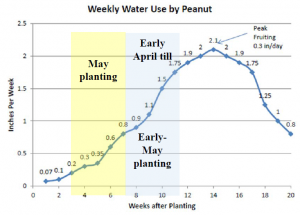Peanut Disease Management Decisions for the Month of June
Robert Kemerait, Professor and Extension Specialist
University of Georgia
“In 2000, when I started, most fungicide programs started with chlorothalonil applications, 1.5 pt/A, at approximately 30 and 44 days after planting. Some growers substituted Tilt/Bravo in one or both of these application timings; however fungicide programs all typically included 30 and 44 DAP applications. There is nothing wrong with such a strategy, but here are the new opportunities and options for our fungicide options following planting and through the first six weeks of the season:
1. 30 and 44 days after planting remain important dates for establishing a good leaf spot program. These applications generally insure that the crop is protected before any significant infection by leaf spot pathogens has occurred.
2. Seventeen years ago, most growers were using chlorothalonil or Tilt/Bravo; today there are an increased number of options and also Tilt/Bravo is not to be used.
3. On well-rotated fields and/or where a more-leaf-spot-resistant variety is planted, use of chlorothalonil is likely appropriate and economical. However, where risk to leaf spot is
increased (for example, as measured using Peanut Rx), or for increased “insurance, it often becomes prudent to be more aggressive with a leaf spot program. More aggressive leaf spot programs include fungicides early in the season with greater systemic activity (chlorothalonil is only a protectant).
4. Today, growers can also use a fungicide like Priaxor (6 fl oz/A) at 45 days after planting and set the base for a strong leaf spot program with only one fungicide application in the first six weeks after planting.
Lastly, tebuconazole is so inexpensive these days that many growers see that including it with early-season leaf spot applications does not increase cost and may help in establishing the most robust white mold program.”
Peanut Weekly Water Use Chart
Wesley Porter, Extension Precision Ag and Irrigation Specialist,

Watermelon Downy Mildew
Be aware that it has been found in watermelons in Tatnall County (about 85 miles from Cook Co as the crow flies). You can track downy mildew at “Cucurbit Downy Mildew Forecasting” at https://cdm.ipmpipe.org/. Bhabesh Dutta (UGA Vegetable Pathologist) has the following recommendations:
“Watermelon: Rotation (foliar application) with Orondis Ultra + Manzate; Ranman + Manzate; Previcur flex +Manzate. Please be mindful on the post harvest intervals for recommended fungicide.”
Corn and Soybean Disease Update from Bob Kemerait on June 5
- Southern rust has finally been identified in Georgia. Rome Ethredge contacted me this afternoon after finding a very limited amount of southern corn rust on corn in the silking (R2) stage. This is likely some of the earliest southern rust to affect our state.
- Weather condition for the past few days and over the next few days is predicted to have a significant chance of rain and humid conditions. These conditions are quite favorable for the development and spread of rust diseases to include southern corn rust and Asian soybean rust.
- As of today, 5 June- Asian soybean rust has been found on kudzu in Miller County and on corn in Seminole County.
- My recommendations: Corn in southern Georgia that is approaching tassel stage (or has reached) is now at some risk to southern corn rust. The risk is likely not urgent yet, but finding rust now (fairly early in the season) and coupled with the current weather conditions does increase risk.
- Grower spraying for southern corn rust: tebuconazole is effective, but combination products that include multiple modes of action (e.g. strobilurins, triazoles, SDHIs) have a broader spectrum of activity against disease AND have a longer protective window (e.g., 3 weeks versus 2 weeks.)
Cotton, Peanut, Soybean Scout School
Call Debbie Rutland 229-386-3424 for more information. Insect Scouting Schools will be conducted on June 12, 2017 in Tifton. Crops to be covered include cotton, peanuts, and soybean. These programs offer basic information on insect pest identification and damage, natural enemies, and scouting procedures. The training will serve as an introduction to insect monitoring for new scouts and as a review for experienced scouts and producers. Program topics will include bug pests, caterpillar pests, beneficial insects, scouting procedures, safety, and an in-field review. Each program will begin at 9:00 a.m. and conclude at 12:30 p.m.